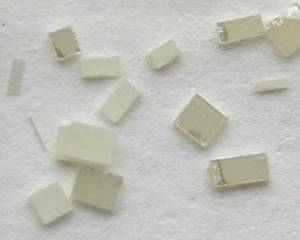Generating Hydrogen from Solar Power
Interview with
Chris - Embarrassingly for the average Aussie, as a nation, they're amongst the worst emitters of greenhouse gases on a per capita basis of any country in the world. So why aren't they making more use of all that lovely sunshine they enjoy? Leigh Sheppard...
Leigh - We're interested in generating alternatives as a substitute for fossil fuels. So, we're focusing on splitting water to produce hydrogen from sunlight using various catalyst materials.
Chris - How are you doing it?

Leigh - We're using a material based on titanium dioxide which is a very common material that's in a host of common things like white paint, sun cream and toothpaste. It's a metal oxide, so there's metals and there's oxygens. If we change the ratio of those metals to oxygens, we change the properties. So, we take our material, we put it in high temperature, various gas atmospheres, and we're able to sometimes suck oxygen out, and sometimes impose oxygen in. As a result, we have titanium dioxide that's a little bit tweaked. A little bit different from what you would get normally and it has different properties as a result.
Chris - So you fabricate the structure then you illuminate it in the presence of water, and it degrades water molecules, and yields hydrogen and oxygen.
Leigh - That's exactly right, yes.
Chris - So practically speaking, how does it actually work?
Leigh - Okay, what happens is, when the sun or any light source illuminates the titanium dioxide, some of that light, the high energy part of that light, forms electronic charge carriers - like electricity inside the material. Once that happens, we drive essentially electrochemical water splitting. So it's like an old fashioned beaker with two copper electrodes, plugged into a power point somewhere and you split water, same sort of experiment we're doing except that one of those electrodes can't be copper. It has to be a material that's powered by the sun.
Chris - And that's the titanium dioxide.
Leigh - That's right, yes.
Chris - So you make some electrons or a surplus of electricity in one of the electrodes, harvest that off and then use that to split the water.
Leigh - Yeah. In simple terms, that's exactly right.
Chris - So this is a way of basically producing clean hydrogen.

Leigh - Yes. One of the problems of hydrogen today is that it predominantly comes from natural gas. So while hydrogen itself, if you had that in a car, you'd be driving along and only steam is coming out of the back, you can feel good about yourself, but that hydrogen has come from a dirty source. It's come from a carbon source. We want to break that link and we want to produce hydrogen in a way that's entirely free of carbon emission.
Chris - Can you do it in a way that's economical and also, environmentally sustainable though? How much hydrogen can you make?
Leigh - This is the challenge. It all comes down to performance and for us, this is early days. It's an important project. I think it has important consequences for the future as we all rely on energy, but it is early days and it's about lifting performance, and absorbing more sun, and splitting more water. That's what it's all about.
Chris - But how much can you make? In other words, how much sunlight do you need to make hydrogen that would be sufficient for me to run my car to get me to work?
Leigh - Well, this is the question that comes back to efficiency ultimately. At the moment, efficiencies are very low. It's not practical at this stage to split water using sunlight to drive something like a car. It's too early a technological development to do that sort of thing.
Chris - So what makes you think that titanium dioxide's the way to do it? There must be other materials that are better.
Leigh - The virtue of titanium dioxide is that it is highly corrosion resistant. There are a number of other materials that have better abilities to absorb sunlight, but of those materials, they're either extremely expensive or they don't last long in an aqueous environment. You need to start with an oxide essentially and like I said before, it's all about changing the properties of this material. You start off with something that's corrosion resistant and abundant and cheap, but it has its drawbacks and that's what we are about addressing.
Chris - And so, what would be the long term goal of this? Would you have some kind of centralised system where you have big arrays of panels that would make enormous amounts of hydrogen which you then distribute or could you see this even being practical on a domestic basis where people make homemade hydrogen that then powers their home, powers their car, and so on?
Leigh - What I would like to see would be a situation where people can take a bit of control over the energy production as well as energy consumption like we have now. Whether this is something that is favourable on a big scale, time will tell. This is just my personal preference at this stage.










Comments
Add a comment